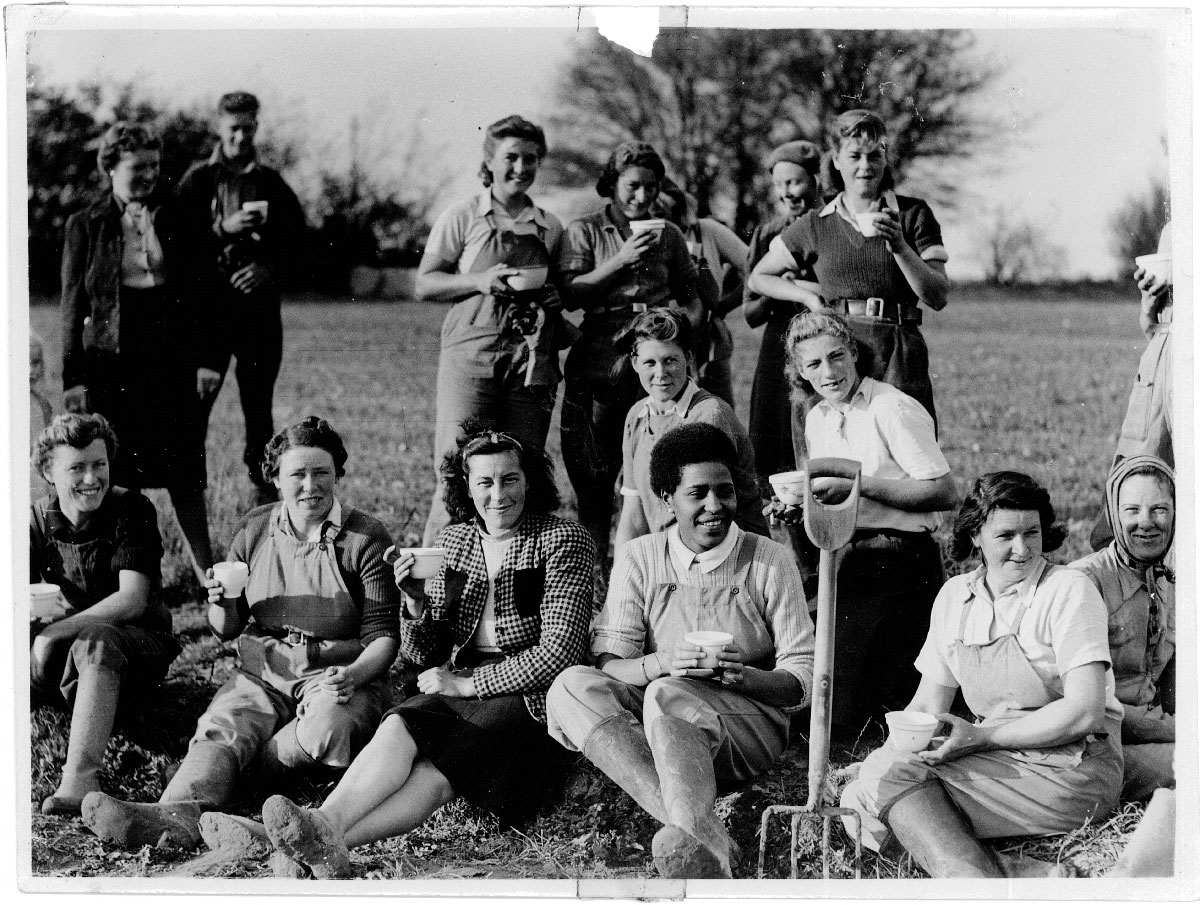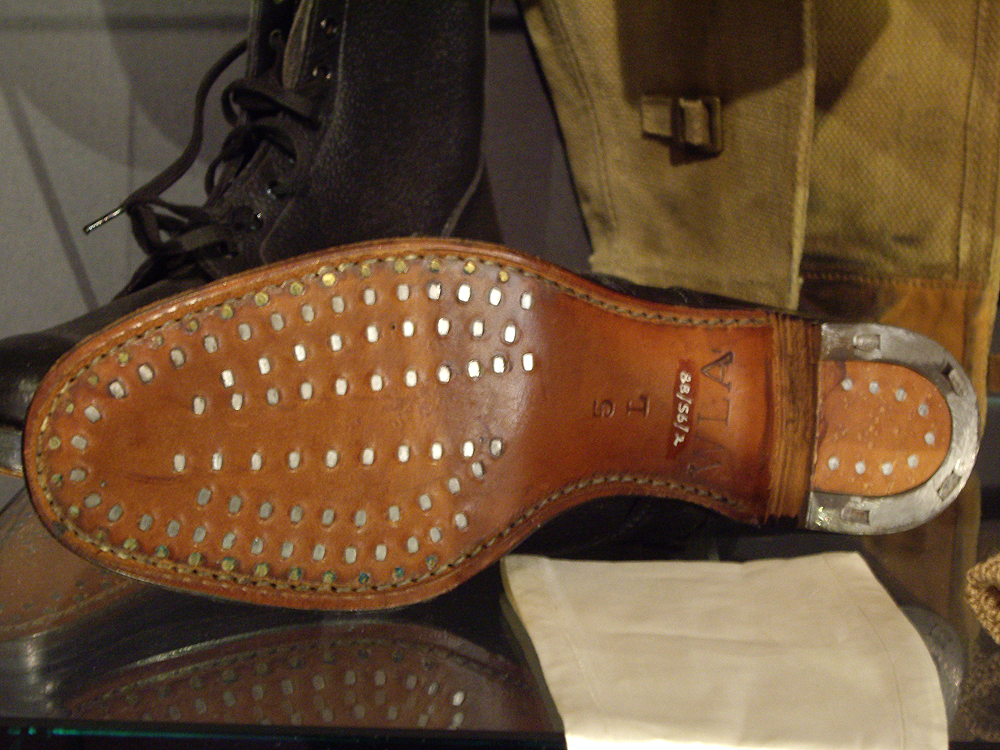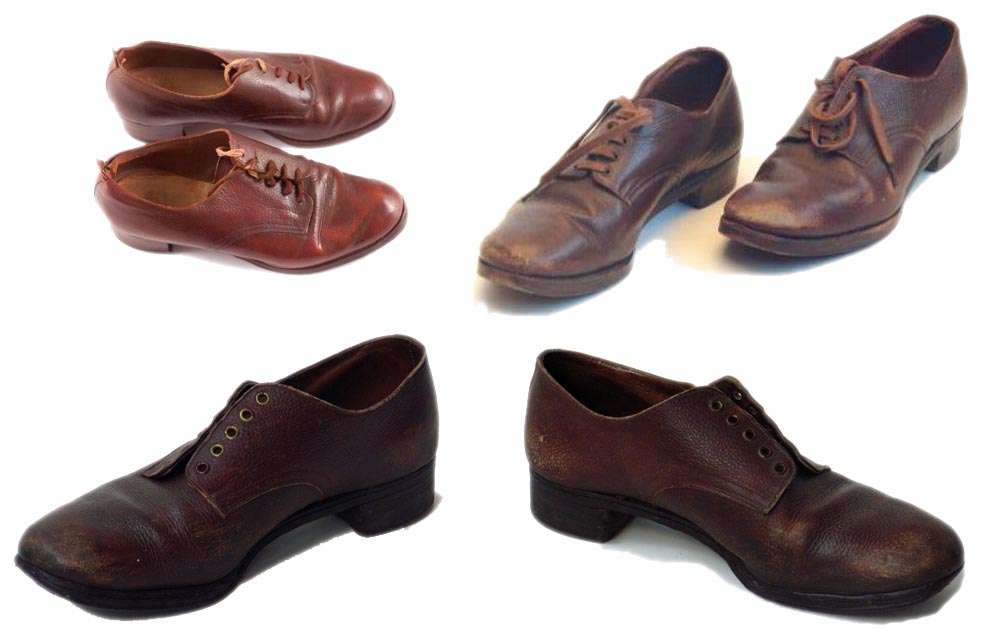Object-handling at home – Women’s Land Army shoes

In this post our curator, Ollie Douglas, introduces us to explore shoes issued to members of the Women’s Land Army during the Second World War and invites us to visit our new online ‘Land Girls’ exhibition. He describes some simple, hands-on (and ‘feet-in’) ways for us to learn about the footwear given to ‘land girls’, encouraging us to think about the lives of people who struggle to gain the recognition they deserve.
Today we’re going to step into the shoes of a ‘land girl’, this being the popular name for members of the Women’s Land Army (WLA). The WLA was established during the First World War to meet food security challenges and keep the UK farming when many workers were fighting abroad. The WLA was reformed in the Second World War. Membership was initially voluntary but later bolstered by conscription. As with military service, members were issued with a uniform and adhered to strict rules governing how it should be worn.
Imagine coming to live and work on a farm for the very first time. How might you feel? It was not until much later that these brave women received medals to thank them for facing this challenge. This new online exhibition features portraits of a handful of the women who deserve our gratitude. You can find out more about relevant collections and discover how to share your own WLA experiences with us here. You may also be interested in this resource, which reveals many additional WLA histories. In recent decades much has been done to highlight the wartime experiences of people whose stories have been sidelined or have been ignored. Many land girls remain unknown to us.
To follow this handling from home activity you’ll need to examine the footwear in your house. This could be yours, or it might belong to another member of your household. Remember to ask permission and to wash your hands after handling footwear! We’ll be using your own boots and shoes to help us think about how WLA footwear was made, what it might have been like to wear or work in, and to reveal a few more secrets about life as a land girl. So, grab some footwear and let’s get started.
1. What types of footwear do you have in the house and what are they made from? Land girls were issued with a pair of shoes and – depending on when they enlisted – a pair of gumboots (wellies) or strong boots for wet weather. In this striking image land girl Amelia King wears a pair of 1940s gumboots. We’ll return to Amelia’s story below so read on to find out more. As well as wellies and waterproofed boots, standard shoes formed part of the uniform as well as being designed for farm use. What hard-wearing footwear do you have in your house? Would the same footwear look good as part of a military uniform?

2. Let’s think about materials. How much of the footwear in your household is made from natural materials and how much from synthetics? Many modern wellies are made from PVC but in the 1930s and 1940s they were made from natural rubber. In 1942 a shortage of natural rubber imports meant they were sometimes hard to source. The problem was even raised in parliament and the decision was made to provide strong leather boots to many land girls instead. Like the shoes, these boots were made from leather, another naturally-derived material.
3. You can tell if footwear has been used by looking for scuff marks, dirt, and wear on the soles. Has all the footwear in your house been heavily worn? The WLA boots had hob-nailed soles, meaning the leather was studded with metal to make them tougher. This pair at The MERL was made by Coles of Burton Latimer, Nottinghamshire. As you can see from the photo, the soles remain unmarked. This has nothing to do with the tough hobnails. Some land girls later recalled how uncomfortable the boots were, which almost certainly explains why this pair was never used!

4. Look at footwear belonging to different people in your household. An individual’s gait (the way they walk) causes footwear to wear in different ways. Leather boots and shoes can be hard to ‘break in’ but over time their fit improves. This may be another reason why the boots were never worn. Footwear grows person-specific over time. The MERL holds several pairs of WLA shoes – also made by Coles – that belonged to different land girls. Each pair reveals a different pattern of wear. It’s like a signature, telling the story of the women who wore them.
5. Have any shoes in your household been treated or repaired? They might have new soles or laces, or may have been been polished or waterproofed. One pair of shoes at The MERL has no shoelaces, so they either wore out or were taken to lace another pair of shoes. Another belonged to Gwen Hayes who had them re-shod (had the soles replaced). A third pair, which belonged to Mrs I. E. Davies (née White), features the words ‘please grease me’ inscribed on the sole. These are useful reminders that we should look after our footwear. This recent exhibition explores ‘make do and mend’ during wartime and today’s trend for ‘fast fashion’.

6. Sometimes things can’t be easily mended. As we learned when we used t-shirts to think about smocks, when some things get old we just throw them away. As a result of this The MERL has no examples of WLA-issue gumboots like those worn by Amelia King in the image above. Indeed, one of the few pairs of wellies we do have belonged to the founder of Glastonbury. A different history altogether! The fact that land girls kept their shoes reveals how we treat different types of footwear differently. We know that leather shoes can be easily repaired so we are much more likely to keep an old pair of those than a pair of leaky rubber wellies.
7. Have a good look at the footwear in your household. What markings can you see? There might be a brand name or a size. It might state the country of manufacture. How much of the footwear in your house was made in the UK? The Coles company name appears on all the WLA shoes and boots at The MERL. They also have the year they were made. If we look carefully we also find another mark that looks like an arrow. Sometimes this has a W and D on either side. This is a War Department mark. So, if you ever see an old pair of brown shoes (or unworn black boots) in a charity shop or a jumble sale, check them for a secret little arrow symbol, just in case….
Now, it’s time to put your own footwear away and wash your hands. While you do this try to think yourself in the shoes of those who wore WLA footwear. Think about those who receive our thanks for their hard work and those whose stories have been (and sometimes still are) overlooked.
Finally, let us return briefly to stories that are absent from The MERL. Amelia King (pictured above) was initially refused entry to the WLA because of the colour of her skin. We don’t hold her gumboots and the image above actually comes from Wickham History Society, but her experience is one that still deserves to be more widely known. She faced racism for offering to help and her efforts went under-acknowledged just like those of her fellow land girls. So, in this extra blog post, Tamisan Latherow brings more of Amelia’s fascinating story to light. We’re also taking this opportunity to encourage you to take a look at The Lost Land Girl, which takes a creative approach to exploring the need to acknowledge the contribution of people of colour during the Second World War. Supported through the BFI Network, this new short film tells the fictional story of two Black British sisters who become land girls. Watch the trailer here and keep an eye out for screenings, which should be coming soon.
We know who wore the WLA footwear we hold at The MERL but for us it stands for all other land girls, and the brilliant work they did no-matter who they were.
Wickham History Society has a local history board outside Wickham Community Centre (Mill Lane, PO17 5AL) referring to the WLA and to Amelia King’s successful struggle to join. The site is close to Frith Farm where she worked. We are grateful to the Society for allowing us to reproduce the image of Amelia King above.
